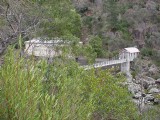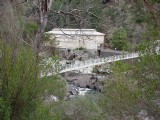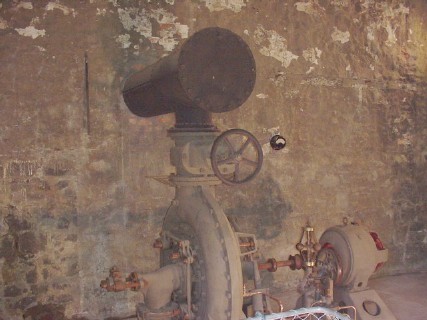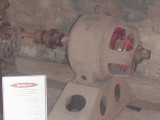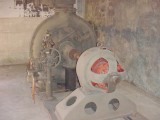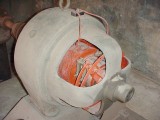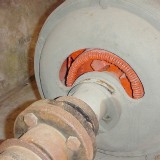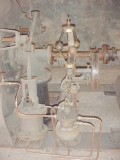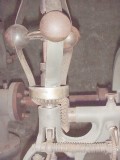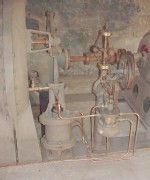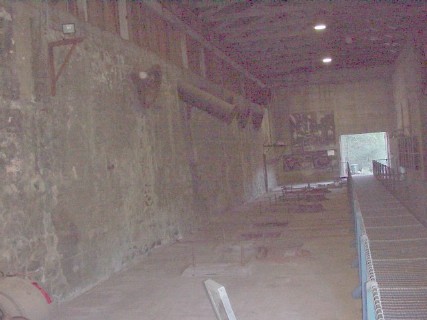
If you've had a look around this website, you've probably realized that
there is an underlying theme. My contention is that it is possible to
work toward a sane, just world, in which ordinary people have a genuine
chance to live a life of fulfilment and creativity; and that a significant
part of this has to do with access for all to cheap, clean, safe energy.
I'm under no illusions. I don't for one moment imagine that any scientific
or technological breakthrough is going to change human nature. Short of
divine intervention, there will always be greed, bigotry, murder, war, and
related horrors, even if people of goodwill do succeed in removing any
logical pretext for these to persist.
Nevertheless, that doesn't mean that we shouldn't at least try to make our
little ball of rock a better place to live. The alternative is to throw our
hands up in despair, and simply let it all come unravelled; to be part of
the problem, rather than engaged in seeking possible solutions. If we just
sit on our hands and wait for divine intervention, we could be doing so
(quite literally) until doomsday.
One person who dreamed of a better world, and had visions of how to make a
start, was Nikola Tesla (1856-1943). (Again, if you've visited other pages
within my website, very likely you'll know that this has a lot to do with my
main theme.)
Before moving on, may I urge you to visit
this page
and follow the links to read a brief but well-written synopsis of Tesla's
life and times. It's a fascinating and disturbing story.
One of those links -
this one
- relates how Tesla and George Westinghouse made history in 1896 by
harnessing some of the immense energy at Niagara Falls to produce
hydroelectric power for New York and surrounding areas, thus establishing
alternating current (AC) as the world standard for power generation and
distribution.
Launceston, Tasmania's second largest city (after Hobart, the capital), also
has a claim to fame in the electric power story (albeit a more modest one
than Niagara).
In 1895, the first publicly-owned hydroelectric scheme in the southern
hemisphere began operations at Duck Reach on the South Esk River. Initially,
the power was used only for Launceston's street lighting; but demand grew
rapidly, and the system was progressively upgraded over 16 years to the
point where its capacity was two megawatts (double the capacity when it was
first built). Eventually, the old facility was replaced with a bigger one:
the
Trevallyn power station
(also
here),
which commenced operations in 1955, and continues to power the city to this
day.
This
Wikipedia page gives a very short historical overview of the Duck Reach
Power Station, and provides a black-and-white picture of the original
building, taken before it was badly damaged during the 1929 flood.
The old station, no longer functional (since 1956), is now open to the
public as part of Launceston's Queen Victoria Museum and Art Gallery. In
early August, 2006, I went to the old power station with my recently
acquired digital camera (a clunky old Sony Mavica FD88, to match my clunky
old computer and my clunky old self) and took some pictures.
To get there, you drive a short distance out of the city down Corin Street
[named after Launceston's City Electrical Engineer
William Corin
(1867-1929), controller of the power station until 1907] until you come to
a dead end. There's a place to park your car, and some signs informing you
that you've come to the right spot...
... and there it is, down there...
Well, we made it across the river without getting washed away - phew!
The bridge was wiped out again in the 1969 flood (although the pylons
survived), and wasn't replaced until 1995. It was opened on the centenary of
the original opening of the power station.
The small building at the northern end of the bridge houses the machinery
for the old flying fox, by which materials were sent across the river
during construction. Let's turn left and walk toward the main building.
Hang on - there's another sign down there, near the end of the bridge...
Ooooh - well, we won't go there. Instead, let's have a look inside the
building.
At the end of its working life, the power station was left derelict for 40
years until 1995, when the suspension bridge (destroyed for the second time
in the 1969 flood, as mentioned earlier) was again replaced and the building
was opened to the public. (This, my first visit, was in early August, 2006!
I can't think why I didn't come here and have a look around ages ago.)
All right - let's go back in, and see what's along the back wall of the old
plant.
Ah - now this is interesting!
Remember how, when we came in, we could see some mechanical-looking gizmo in
the far right-hand corner? Well, this is it - it's one of the old "machine
sets".
There are three main components of this system:
1.
At the left is the turbine, which was driven by water entering from
above and exiting below to the river. Its overall diameter is about 1.5m (5
feet).
2.
At the right-hand end is the alternator, which was driven by the turbine via
a common rotating shaft, and produced AC power. (Car alternators also
produce AC, but they are fitted with diodes which turn it into DC - see
this page
for a good explanation.) Its diameter is about 60cm (2 feet).
3.
At front centre is the governor, a device which prevented rotation at too
high a speed. It was belt-driven by a pulley-wheel on the main shaft. At
high speeds, the three spring-loaded metal balls (each about 7cm in
diameter) would fly outward owing to the centrifugal effect, thus tending to
slow the rotation (in much the same way that a pirouetting ice-skater's arms
can be drawn in or spread out to control speed of rotation). The
pulley-wheels can be clearly seen, but the belt is no longer there. The
overall height of the governor (above its bearings) is about 45cm (1.5
feet).
Click
here
to see a blow-up of the explanatory sign at the right-hand lower corner of
the above picture.
The next picture, of the top part of the turbine, shows the inlet pipe
through the back wall which connected to the penstock (the large pipe which
conducted water to the power station from uphill).
The circular handle controls a valve which could be used to regulate the
flow.
Just to the right, you can see a meter attached to the wall. Here's a
close-up:
This raises the question: what's a DC (direct current) voltmeter doing in a
system which is supposed to produce AC?
A possible answer lies in the fact that this power station once featured not
only alternators (five of them), but also three dynamos, which
generated DC. These were used to run arc lights placed in some of
Launceston's streets in those early years. Perhaps this spot was originally
occupied by one of the dynamos; or perhaps the DC meter was placed here by
mistake during the 1995 restoration - I don't know. (I might pursue the
matter at some stage - stay tuned...)
MAJOR UPDATE, Tuesday, 4th October 2011
Well! Some information has come to light.
There's a move afoot to get this old power station up and running again -
partly as a working museum and tourist attraction, and partly to generate
some real power as a commercial enterprise. I went along to a meeting about
this last Sunday (2nd October), with the intention of becoming involved, if
possible, in what sounds like a great idea. As you might expect, I'm
all for it - and I really hope it all happens as intended!
After the meeting I talked to a gentleman who also has a strong interest in
the place; in fact, his interest predates mine by several decades. He is
quite knowledgeable about many of the technical details, and is keen - as I
and several others are - to locate as many as possible of the original
components and bring them back to where they belong, right here in our old
Duck Reach Power Station, where they may have a second life alongside some
more modern machinery to be (hopefully) introduced also.
We discussed the old generator mentioned above. Apparently, it's in good
condition, and could be put to work again. More to the point, however, it
seems that what has been billed as an AC generator, or alternator
(which I'd suspected was a
two-phase
alternator), is nothing of the kind: it's actually a dynamo, i.e. a
DC generator, capable of producing 55 volts DC at 270 amps. This translates
into a DC power output of 55 × 270 = 14,850 watts, or 14.85 kilowatts. The
dynamo may have been used to run arc lighting in Launceston's streets (as
mentioned earlier), and/or it may have been used as an energizer to
power the field magnets of one or more of the larger alternators.
- All of which I find quite fascinating. It also explains a few things:
•
firstly, it explains the presence of the DC meter on the wall behind the
old machine;
•
secondly, it explains why there are only two connections from the generator
to the "outside world", rather than four (or perhaps three) if it were,
indeed, a two-phase machine of some kind;
•
and thirdly, it explains why the wire used for the windings - visible
through the gaps in the casing - is so thick! (See the photos below.)
It would need to be quite substantial, to handle 270 amps safely.
(In fact, those gaps are probably there to help prevent overheating.)
In the light of these revelations, the facts contained in the Wikipedia
page mentioned earlier
(here's
the link again, for convenience) can perhaps be more easily understood.
(Note also that my earlier statement that there were originally three
dynamos and five alternators is incorrect; there were actually five dynamos
and three alternators.)
Another web-page with some interesting historical background is
here.
Do keep visiting this page - I'll update it with further information as
such becomes available.
- - - - - - - - - -
Next, some more detailed shots of the alternator - er, dynamo...
... and the governor:
It can be seen how the governor's pulley was run from the main shaft, how
the rotary motion was transferred to the vertical rod by a pair of bevel
gears, and how a hydraulic system which took water from the turbine could be
used to fine-tune the governor's operation.
That's it, basically! Before leaving, let's look along the north
wall, into the gloom, to see the inlet pipes for the other machines which
used to grace this old hall:
Outside again, let's have a look at some more of the pipework.
Photographs taken from halfway along the bridge:
As mentioned elsewhere in these pages, we owe an enormous debt to the
pioneers of electrical science who made our modern lifestyle possible, in
particular:
Oersted, whose sharp observational powers enabled him to make the connection
between electricity and magnetism, and conduct some early experiments;
Faraday and Henry, who investigated electromagnetic induction, thus paving
the way for the introduction of practical electric power;
and Tesla, whose inventive genius and determination led to the widespread
use of machinery such as that in the Niagara Falls and Duck Reach power
stations, and to the large modern AC systems we all take for granted today.
But - is that it? Have we arrived where we want to be? Has the final story
been told?
Tesla, a restless soul and a true inventor, was never satisfied with his
most recent triumph. He was always seeking for even better ways to fulfil
his dream of the high quality of life he envisioned for all the world's
people.
Having succeeded in harnessing Niagara, and having discovered the basic
principles of radio, he went on to perform experiments which showed that it
was possible to transmit useful electric power without wires. Not just
signals for communication, but practical power to run
electrical appliances. He once lit 200 light bulbs, 40 kilometres (25 miles)
away, by wireless transmission.
He lost support from his backers around that time, because they couldn't see
that there was any way to make money from such a system. Thus his dream of
electrifying the entire earth to provide practical power for all was never
realized.
Whether this "Tesla coil" approach to large-scale power distribution would
have ever been practical is not really the issue. The point is, Tesla was
convinced that there must be some way to harness what he called
"radiant energy", or "cosmic rays". (That latter term now refers to
something quite different, of course.)
The technology of Niagara and Duck Reach was great in its time - but that
all happened well over a hundred years ago! A century later, all over the
world, we still have power lines criss-crossing the landscape, power cuts,
and large electricity bills - all of which should by now be a thing of the
distant past. I'm quite certain that Tesla would be absolutely horrified,
were he still alive today, to see that we've stood still for so long, and
are hamstrung by technology which really does belong in a museum.
The crucial aspect of large-scale power-generation plants is that
something has to drive the machines that generate the power.
In many places, this involves the burning of fossil fuels which produces
carbon dioxide, thus contributing to global warming. (Even in the late
1800's, Tesla was aware that there was a problem with the
burning of coal,
the fossil fuel of that era.)
In other situations, it involves nuclear fission - also an old technology,
and an inherently dangerous one, notwithstanding the recent spate of claims
to the contrary from our political masters.
In Tasmania and other places (including Niagara, of course), hydroelectric
power is generated by falling water. In "run-of-the-river" systems like Duck
Reach, this simply involves diverting some river-water for a short distance;
but in many (most?) cases, it involves the building of large dams, thus
significantly impacting on the environment. In Tasmania in the 1970's and
early 1980's, this became a vexed issue and ultimately led to the formation
of the Green movement, which has since spread around the world. (I took part
in the Hobart demonstrations against the
Franklin Dam
in the early 1980's - and I'd do it again, without a second thought, if the
need arose.)
If you'd like to see more of my ramblings on these and related matters,
click
here
to see my "It's still not easy being green" page (added in November
2006).
The point is this:
With existing power generation technology - whether in a modern, spick and
span, computer-controlled power station, or in an old-fashioned but charming
"dive" like our Duck Reach plant - it's necessary to impact in some way on
the environment to run the machines. All we're doing is moving the problem
back one step; but the problem is still there.
It's possible that new technology which taps into
zero-point energy
may raise problems of its own. It's been suggested that, if everyone in the
world had their own small power-plant and used it without restriction, the
amount of ZPE which would thus ultimately be converted to waste-heat may
have its own significant planet-warming effect. - Or there may be other
difficulties.
So do we just give up on it, without even bothering to check it out? Or do
we engage the best scientific minds to conduct a thorough investigation,
identify any problems, and make a concerted attempt to solve them?
Frankly, with the world at a crossroads, what's the alternative?
The time for change is now. It's becoming clear to many that there is
a better way. In a world facing disaster, we need to be putting pressure on
our political leaders to WAKE UP and start addressing the issues I've
tried to highlight in these pages. If we start straight away, we have a
chance - but there's no time to lose.
To coin a phrase by John Lennon:
"Power to the people? - RIGHT ON!"
My home page
Preliminaries (Copyright, Safety)
"Power to the people"


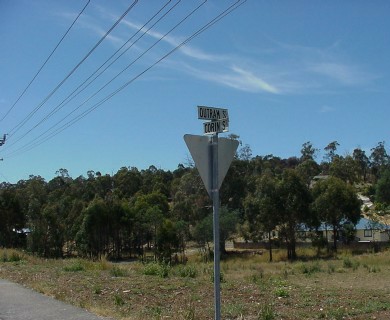
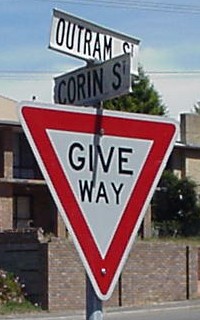
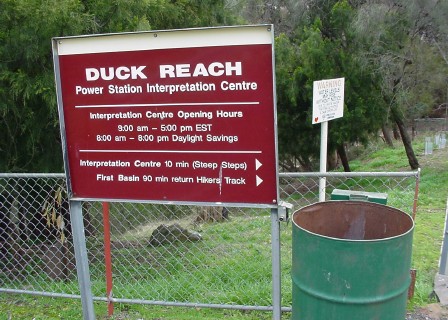
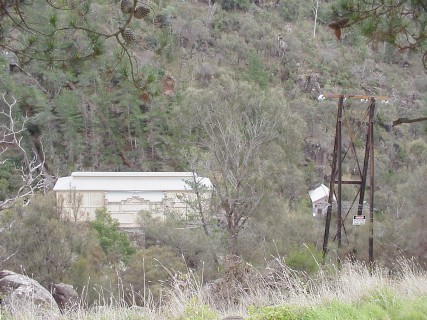
"Let me take you down..."
You can click on the following small pictures to see bigger versions.
 Just to the right of the first sign (see above)
Just to the right of the first sign (see above)
is this one, warning of possible flooding.
UPDATE, 15th January, 2007
This sign now has its own story! Click
here
to read more...
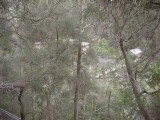
If you go down...
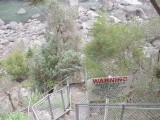
... big surprise...?
Well, let's not go down to the river bank, just in case -
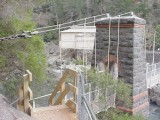
- instead, let's turn left and go to the suspension bridge.
The original bridge was destroyed in the 1929 flood.
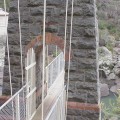
The beautiful old bluestone pylon at
the southern end survived the flood...
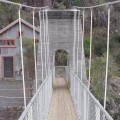
... but the one at the northern end didn't, and was
replaced with one built from reinforced concrete.
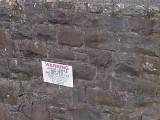
... could somebody be trying to tell us something...?
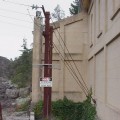
Here's another sign - different, but no less alarming!


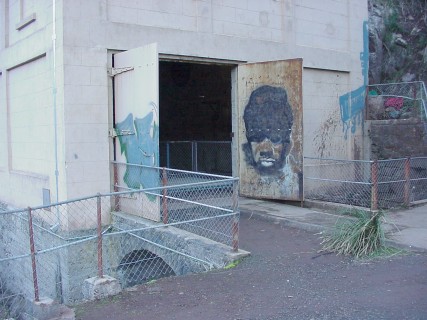
Don't be frightened! (You can hold my hand if you like.)
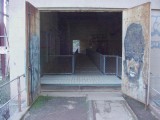
Looks very dark and spooky in there, doesn't it...?
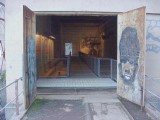
... but there's a motion detector just inside the door which
switches on some lights as soon as you get close enough.

Along the south wall (on the left) are some placards which
present a history of the place. Apart from that, it looks a
bit empty - although there might be something interesting
down the other end, in the north-west corner.
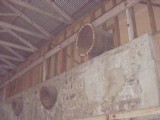
A quick look up and to the right, at the north wall, to see
some of the pipework which used to bring the water in.
With no windows, the only natural light comes through the
doors and those old pipes. The keyword here is gloomy.

Moving past the placards, let's look over to the left, into
the alcove in the south wall. Hello - whatever's this?

Somebody's been here before us - and extremely busy!
(I did mention earlier that this place was now run by the
Queen Victoria Museum and Art Gallery, didn't I?  )
)
 Okay - so this section used to be the Switchroom.
Okay - so this section used to be the Switchroom.
The south wall had to be rebuilt after the 1929 flood,
so we can be quite sure that Engineer Corin never saw
this paint job. (I doubt that he would have approved!)

While we're at it, we might as well check
out the rest of the graffiti in this area...

... and here's the last bit.
I seem to recall someone I know once describing this
place as "a bit of a dive". I think I can see why...
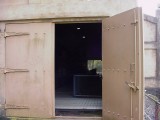
There's nothing very exciting on the last section of the
south wall. Let's go out through the west door for a
minute before exploring the north side of the building.
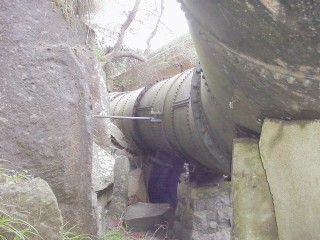 While we're out here, we might as well clamber up the slope and have a look
behind the power station.
While we're out here, we might as well clamber up the slope and have a look
behind the power station.
The pipe coming down the hill turns left to go behind the building, and
connects to the inlet pipes along the western half.
(We'll check out the situation at the eastern end when we've finished
exploring inside.)
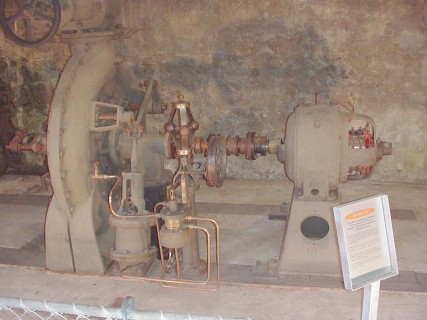
(Click to see a larger version, for this and subsequent pictures)

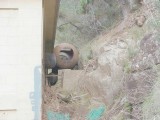
If we stick our respective noses around the north-east
corner, this is what we can see. To get a better view,
we'll have to climb up the hill.
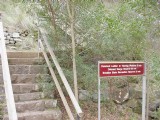
Fortunately, there's a track called the "Penstock Ladder"
behind the power station which is exactly what we need.
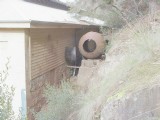
This is the view from the top of
the steps in the last picture...
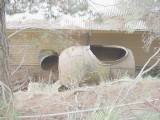
... and walking along the track behind the building
reveals more details about this mysterious object.
You might have been wondering if some strange
mechanical dinosaur hatched out of it, aeons ago
- but it's really just a decrepit old piece of piping!

The track follows the penstock up the hill. It's quite
steep in parts; I was a bit concerned to find this sign.
With my creaky old knees, I did wonder if it would be
wise to continue - but valour won out over discretion.
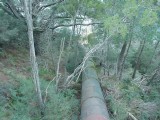
Having made it safely to the viewing platform, this is the
view back down the hill. We're right over the penstock.
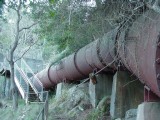
Taking our lives in our hands, let's climb up a bit
further. This is looking back toward the platform...
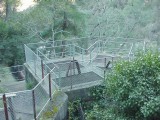
... and this is how it looks from higher up still.
The track goes up a lot further; but, thinking that I'd
better not push my luck, I decided to go back - and
made it, quite safely, facing forward all the way. 
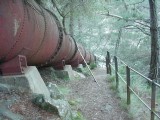
I took a few more pictures of the rusty old
penstock on the way down. Here's one...
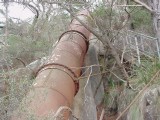
... and here's another. (You can just see the
rear of the building through the vegetation.)
Time to go...

Back at the northern end of the suspension bridge.
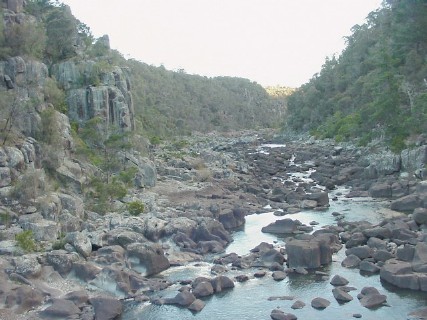
... looking up-river, to the west...
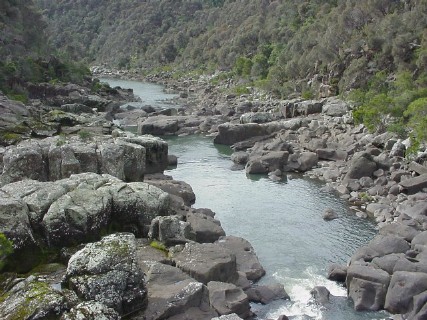
... down-river, to the east...
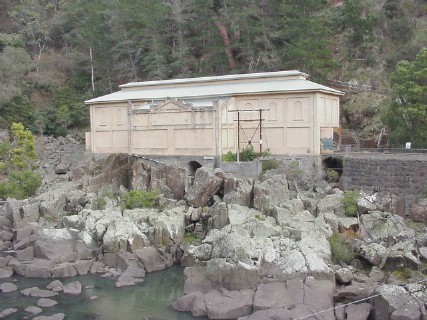
... and back toward the old power station.

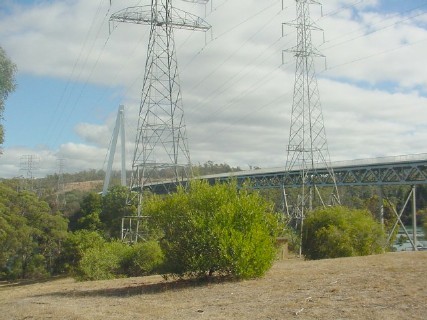
Pylons carrying high-tension power lines near Northern Tasmania's Batman
Bridge
(Click
here
to see my page which discusses this bridge, among other things)


 Return to Electrical stuff menu
Return to Electrical stuff menu


